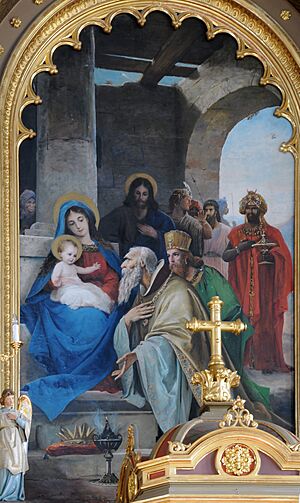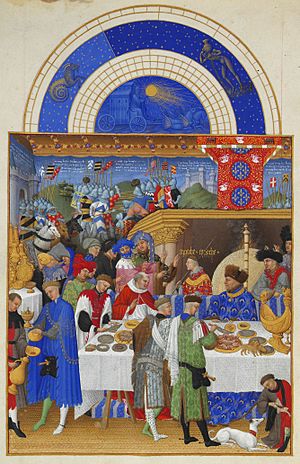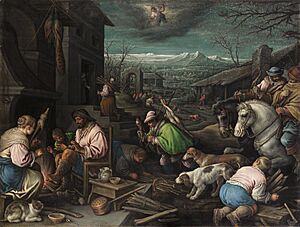January facts for kids
January is the first month of the year in both the Julian and Gregorian calendar systems. It has 31 days. The first day of January is known as New Year's Day.
In the Northern Hemisphere, January is usually the coldest month of the year. It's the second month of winter there. But in the Southern Hemisphere, January is the warmest month, as it's the second month of summer! So, January in the Southern Hemisphere is like July in the Northern Hemisphere, and vice versa.
Long ago, the Ancient Romans had special celebrations in January. These included Cervula and Juvenalia on January 1, and Carmentalia on January 11. These dates were based on their old calendar, which was different from our modern one.
Contents
History of January
The name January comes from the Latin word Ianuarius. It's named after Janus, who was the Roman god of beginnings and changes. Imagine him as a god with two faces, looking both to the past and the future!
The first Roman calendar only had 10 months. Winter was just a period without months. Around 713 BC, a Roman king named Numa Pompilius is thought to have added January and February. This made the calendar closer to a full year. Even though March was originally the first month, January later became the first month of the calendar year.
During the Middle Ages in Europe, people celebrated New Year's Day on different dates, like March 25 or December 25. But by the 16th century, many European countries officially started celebrating January 1 as the beginning of the New Year again.
January has had other names too! The Saxons called it Wulf-monath, meaning "wolf month." Charlemagne called it Wintarmanoth, which means "winter month" or "cold month." In the Slovene language, it's traditionally called prosinec.
January Symbols
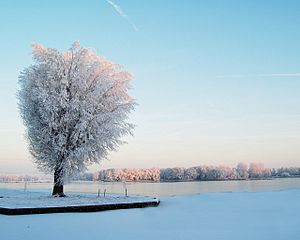
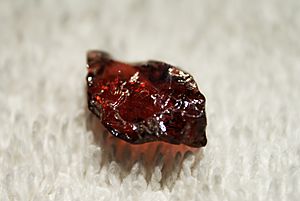
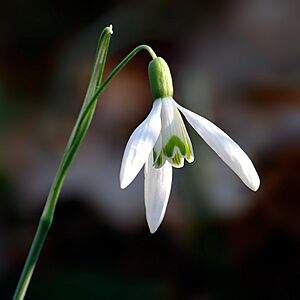
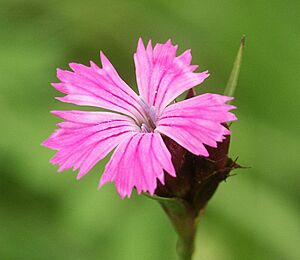
Every month has special symbols! January's birthstone is the garnet. This gem is said to represent being steady and loyal.
The birth flowers for January are the cottage pink Dianthus caryophyllus, also known as the traditional carnation, and the galanthus, or Snowdrop.
If you were born in January, your zodiac sign is either Capricorn (if your birthday is before January 19) or Aquarius (if your birthday is on January 20 or later).
January Observances
Many different events and holidays are celebrated in January around the world. Here are some of them:
Month-long Observances
- Alzheimer's Awareness Month (Canada)
- Dry January (United Kingdom)
- National Mentoring Month (United States)
- Slavery and Human Trafficking Prevention Month (United States)
- Veganuary
Food Months in the United States
- Hot Tea Month
- National Soup Month
- Oatmeal Month
Moveable Observances
Some holidays in January don't fall on the same date every year.
- Second Monday: Coming of Age Day (Japan) - A day for young people who turn 20 to celebrate becoming adults.
- Third Monday: Martin Luther King, Jr. Day (United States) - A holiday honoring the civil rights leader Martin Luther King, Jr.
- Third full week of January: Hunt for Happiness Week (International) - A week to focus on finding joy.
- Last Monday in January: Bubble Wrap Appreciation Day - A fun day to celebrate bubble wrap!
- Monday Closest to January 29: Auckland Anniversary Day (New Zealand)
Fixed Observances
Many holidays and observances happen on the same date each year.
January 1
- New Year's Day - Celebrated worldwide as the start of a new year.
- Constitution Day (Italy) - Celebrates Italy's constitution.
- Euro Day (European Union) - Marks the introduction of the Euro currency.
- Global Family Day - A day to think about peace and sharing.
- Independence Day (Brunei, Cameroon, Haiti, Sudan) - Countries celebrate their freedom.
- Solemnity of Mary, Mother of God (Catholic Church) - A religious holiday, also celebrated as World Day of Peace.
January 2
- Berchtold's Day (Liechtenstein, Switzerland) - A traditional holiday.
- National Science Fiction Day (United States) - A day for science fiction fans.
January 4
- Independence Day (Myanmar) - Myanmar celebrates its freedom.
- World Braille Day - Honors Louis Braille, who invented the reading system for the blind.
January 6
- Epiphany or Three Kings' Day (Western Christianity) - A Christian holiday celebrating the visit of the Wise Men.
- Christmas (Armenian Apostolic Church) - Some Christian churches celebrate Christmas on this day.
January 7
- Christmas (Eastern Orthodox Churches) - Many Eastern Orthodox Christians celebrate Christmas on this day.
- Victory from Genocide Day (Cambodia) - Remembers the end of a difficult period in Cambodia's history.
January 11
- German Apples Day (Germany) - A day to celebrate apples!
- Independence Manifesto Day (Morocco) - Celebrates a step towards Morocco's independence.
January 12
- National Youth Day (India) - Honors the birthday of Swami Vivekananda, a spiritual leader.
- Zanzibar Revolution Day (Tanzania) - Celebrates a revolution in Zanzibar.
January 13
- Constitution Day (Mongolia) - Celebrates Mongolia's constitution.
- Old New Year's Eve (Russia, Ukraine, Serbia) - Some countries celebrate an "Old New Year" based on the Julian calendar.
January 14
- Feast of Divina Pastora (Barquisimeto) - A large religious procession in Venezuela.
- Yennayer (Berbers) - The Berber New Year.
January 15
- Indian Army Day (India) - Honors the Indian Army.
- Wikipedia Day (international observance) - Celebrates the founding of Wikipedia!
January 19
- Theophany / Epiphany (Eastern and Oriental Orthodoxy) - Another Christian holiday, often involving blessings of water.
January 20
- Inauguration Day, (United States) - When the U.S. President takes office, every four years.
- Martyrs' Day (Azerbaijan) - Honors those who died for Azerbaijan's freedom.
January 21
- National Hug Day (United States) - A day to give hugs!
January 22
- Day of Unity of Ukraine (Ukraine) - Celebrates the unification of Ukrainian territories.
January 24
- Unification Day (Romania) - Celebrates the joining of Romanian principalities.
January 25
- Burns night (Scotland) - Celebrates the Scottish poet Robert Burns.
- National Voters' Day (India) - Encourages people to vote.
January 26
- Australia Day (Australia) - Australia's national day.
- Republic Day (India) - India celebrates its constitution coming into effect.
January 27
- International Holocaust Remembrance Day - A day to remember the victims of the Holocaust.
- Family Literacy Day (Canada) - Encourages families to read and learn together.
January 28
- Data Privacy Day (international observance) - A day to learn about protecting your personal information online.
January 29
- Kansas Day (Kansas, United States) - Celebrates Kansas becoming a state.
January 30
- Martyrs' Day (India) - Honors Mahatma Gandhi and others who died for India's freedom.
- World Leprosy Day - Raises awareness about leprosy.
January 31
- Independence Day (Nauru) - Nauru celebrates its freedom.
|
See also
 In Spanish: Enero para niños
In Spanish: Enero para niños


